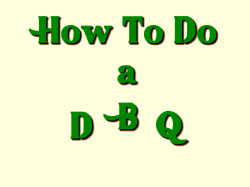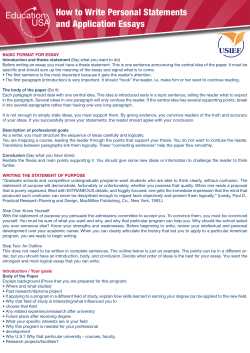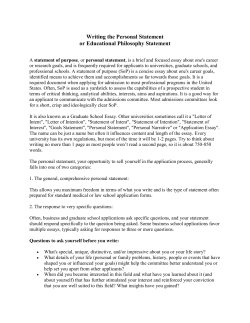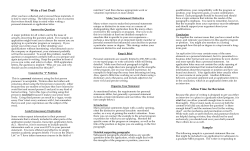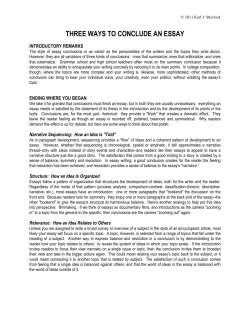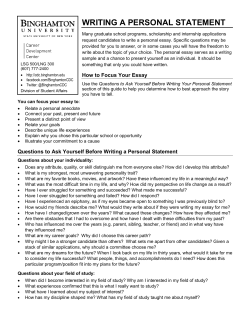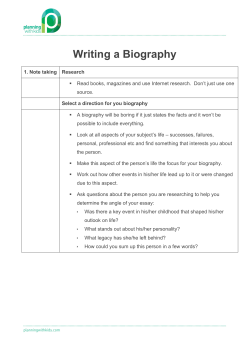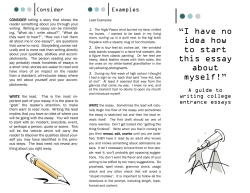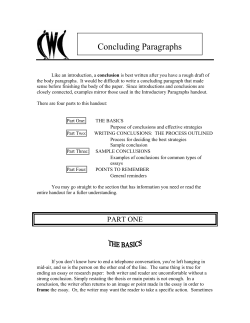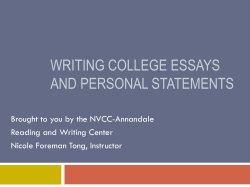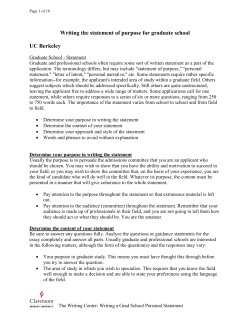
RRHS Guide: How to write an academic persuasive essay
RRHS Guide: How to write an academic persuasive essay Essays in high school, college and university follow a very specific format. The following is a basic guide to formatting an essay without the formatting detail. All your essays, from here on, should follow this format. COVER PAGE AND FORMATTING 1. Your essay needs a cover page. On this white sheet of paper, at the front of your essay, you must have a title for your essay. The title should reflect your opinion. For example, The Return of the Buffalo. Avoid titles that just state the topic. For example, Buffalo. Do not place any graphics on the cover page. The cover page must also contain your name, the course code, the instructor’s name and the date (MLA style only – it is different if it is APA style). The way this information is formatted depends on the style you are using. 2. All academic essays are double-spaced with a 12 size font. Anything larger or smaller is inappropriate. Do not choose scripted fonts but stick to something professional like Arial or Times New Roman. 3. In the MLA style, the first page of the essay contains the title, centered on the page. On the right hand side, at the top of the page, should be a header with your last name and the page number. On each page after this, the last name and page number must be on the right hand top side of the page. 4. When typing your essay, avoid contractions (can’t, won’t, couldn’t). 5. Avoid slang (stuff, kid, cops). 6. Avoid vague language (sort of, kind of, maybe, possibly). Consider who your audience is and use the appropriate vocabulary. 7. Avoid point of view shifts (I to you). Ask your instructor if you can use a first person pronoun (subjective essay) or not. 8. Use spell check and grammar check before conferencing with your instructor. 9. Cite all sources. Anything that is not common knowledge must be cited. Include a works cited page (bibliography), even if you used only one source. The works cited is always placed at the end of the essay on a separate piece of paper. 10. Save a back up copy on the shared drive or a jump drive and keep all rough copies and notes. 11. Follow the directions for turnitin.com How to Write An Academic Essay RRHS – Armistead 2013 Page 1 INTRODUCTION 1. Title The title of your essay is VERY important. It should provide the topic and your opinion of the topic. Use the words of the title in your introduction. The best essays mention the words of the title in the introduction and in the conclusion. 2. Catchy Opening The first few sentences of your essay should catch the reader’s attention. You could use a statistic, an example, a quotation or an anecdote (story). Sometimes a question is asked. The objective is to engage the reader. WARNING: Do not go on so long that your reader loses interest. The very best essays have an idea/question posed in the introduction and this is echoed in the conclusion. For example: Was Macbeth a tragic hero? (introduction) Was Macbeth a tragic hero? He was indeed heroic as he was fierce in battle and strong in purpose. His greatest weakness was his overriding ambition that eventually overtook his life and brought him to his tragic end. (Conclusion) 3. Topic Sentence The topic sentence should tell who/what you are writing about. It should come early in the introduction. NEVER assume your reader knows everything about the topic. You may need to clarify your topic by providing a definition. For example; existentialism, tragic hero etc. Note: If this is a literary essay, you must include the title of the play/book/story, author’s name and provide background information on the main character or the situation to be analyzed. Do NOT refer to characters as people. 4. Thesis A thesis is a sentence or two that presents your opinion about the topic. A good thesis clarifies or explains why you hold this opinion. A good persuasive essay has a strong thesis that gives the essay unity. Avoid ambiguity and vagueness e.g. “I think that maybe the government should fund private schools.” A stronger thesis would be; “The government should fund private schools because (provide reasons here)”. Sometimes the thesis can perform more than one job. For example, the thesis can be the topic sentence and directive statement and thesis all in one. How to Write An Academic Essay RRHS – Armistead 2013 Page 2 5. Directive Statement This is a sentence or two that tells the reader what she can expect to find in the essay or how the essay is organized. For example, “The effects and consequences of illegal drug use are vast.” Avoid overtly stating your directive e.g. “This paper will examine the effects and consequences of illegal drug use.” BODY 1. Transitions Transitions, or linking words/phrases, are used to link the paragraphs together. Each paragraph is like a miniature essay that is organized with a beginning, middle and end. Transitions help the reader make the jump from one paragraph to the next without losing the general idea. By using one or two words, at the beginning of the next paragraph, you can help the reader make connections. Some examples of transitions are: however, for this reason, in conclusion, firstly, secondly, as a result, therefore, in summary, another, as well as, equally important, in addition etc. For a more comprehensive list, refer to the sample list provided. It is a good idea to use transitions, within a paragraph as well. 2. Paragraphs Each new idea should have its own paragraph that proves your opinion. Proof can be in the form of quotations, statistics, examples etc. If you change the topic from elephants to lemons you need a new paragraph. If you change the time or place you also need a new paragraph. If you are writing dialogue, each new speaker needs a new paragraph. Each paragraph is like a miniature essay. It should have a clear introductory statement identifying the idea, followed by supporting details and examples and concluding with a statement that summarizes the details in the paragraph. Summative sentences, at the end of each paragraph, are crucial. They help link back to your original thesis and keep the essay uniform. 3. Quotes When using a quote to support your ideas it is very important you first set it up (i.e. give who is speaking, what their credentials are or what is the context). Then you insert the quote and use it or tie it to your opinion. Example: Dr. Stokes, an expert in the field of clinical psychology states; “The teacher’s fear mongering shows an inherent need for control”. (84). Therefore, fear mongering is not a valued trait but is indicative of weakness not strength. CONCLUSION How to Write An Academic Essay RRHS – Armistead 2013 Page 3 Summarize the main proof. Highlight the most important facts/ideas that support your thesis. Restate the thesis using different vocabulary. It is okay, even preferred if you introduce new ideas in the conclusion that will cause your reader to think. Don’t forget to refer back to the words in your title. You need a catchy closing. The reader should know when the paper is finished. DO NOT write “the end” at the conclusion of a paper. Your conclusion should be sufficient to tell the reader it’s over. You can use a quotation, statistic, an example or anecdote. If you posed a question in your introduction, you should answer it in your conclusion. WORKS CITED 1. If you use sources (such as your novel, encyclopedias, interviews, websites) you must cite ANYTHING THAT IS NOT COMMON KNOWLEDGE and you must do this at the end of each sentence. Failure to do so results in plagiarism. 2. To help you cite your sources visit either citationmachine.net OR http://www.noodletools.com/ and at the bottom of the page click on “Noodle Tools Express”. How to Write An Academic Essay RRHS – Armistead 2013 Page 4 MLA Style - Sample Inside Page Smith 1 New Computer Users and Fear: A Review of Some Related Literature In one of the very first chapters of his book Internet Basics without fear!, Fawcett observed, "It was my fear of technology that drove me in my early days on the Internet" (23). Later in the same chapter he went on to elaborate at length on his experiences: My first experiences with the Internet were not pleasant ones. At that time, most Internet users were hooked-up to public networks known as Freenets. These networks may have been pioneering in many ways, but for the average user at the time, they were extremely tedious and frustrating, sporting technology that, by today's standards, was bordering on primitive. A typical Internet evening involved many long and frustrating hours of fumbling around in 'cyber-blackness'. It frequently took an entire evening just to check my e-mail! A session was often prefaced by hours of busy signals before finally making a connection. (26) According to that author, at that time everything was text-based and menu-driven. Typically, the entire purpose of one's online sessions would be just to send and read e-mails. As he underlines, it was not a user-centric environment, "Only the more savvy 'tekkie-types', went beyond that, often spending endless hours exchanging cyber-musings with like-minded propeller heads." (27) Note: Any quote that is longer than 3 lines is indented on both the left and right sides, single spaced and not placed within quotation marks. In APA style this is how you format any quote longer than 40 words. How to Write An Academic Essay RRHS – Armistead 2013 Page 5 MLA Style - Sample Cover Page New Computer Users and Fear: A Review of Some Related Literature (Title should show topic & opinion) Samantha Smith (Your name) Psychology 101, Semester 2, Class 3A Professor H. Lawson May 2, 2006 (Course Code, Teacher’s Name, Date handing paper in) How to Write An Academic Essay RRHS – Armistead 2013 Page 6 MLA Style - Sample Works Cited Page S. Smith 12 Works Cited Bedford, Frank. "The Psychology of Fear: Is it all in our heads?" The New York Times, 30 Oct. 1990: B4. Chrissie, Sylvia. "Are We Afraid of Our Computers?" The Chicago Tribune, 31 Oct. 1995: D4, D6. Fawcett, Shaun. Internet Basics without fear!, Montreal: Final Draft Publications, 1999. Francis, Veronica. The Fear Experience: Do We Really Know What We're Getting Into? London: Oxford Press, 1985. Gorman, John Richard, and Raymond T. Smithson, The Dynamics of Human Fear Neuroses In the Age of the Modern Computer. Toronto: University of Toronto Press. 1997. 345-53. Hillson, Gregory. "The Unwelcome Eventual Alternative - Computers That Tell Us What To Do." The New Psychologist Dec. 1996: 45-54 Sawyer, David, and Ronald Johnson. The Transference of Fears of Technology To Those Around Us - A Case Study. New York: Holt, Rinehart & Winston, 1987. Transom, Zak, and Steven Rutherford. "The Relationship Between Occasional Writer's Block and Fear of Technology." Psychology Today, Oct. 1991: 82-88. How to Write An Academic Essay RRHS – Armistead 2013 Page 7 Transitions and Linking Words Above Across Against Along Among Around About After At Before During In the same way also Words to show location Away from Beyond Into Behind By Near Below Down Off Beneath In back of Onto Beside In front of On top of Between Inside outside Words to show time First Meanwhile Soon Second Today Later Third Tomorrow Afterward Till Next week Immediately Until Yesterday finally Words to compare Likewise As Similarly But Words to contrast Otherwise Although Yet Still On the other hand Even though Words to emphasize a point For this Truly To repeat reason Again Over Throughout To the right Under Then Next As soon as When Like However To emphasize In fact As a result Last Again And Next Equally important In other words Words to conclude or summarize Finally In conclusion To sum up In summary All in all Words to add information Another For instance Finally Moreover As well Additionally Along with In addition For example For instance Words to clarify That is Therefore Also Besides Likewise Put another way (from Writers Inc: A student handbook for Writing & Learning 1996) How to Write An Academic Essay RRHS – Armistead 2013 Page 8
© Copyright 2025
